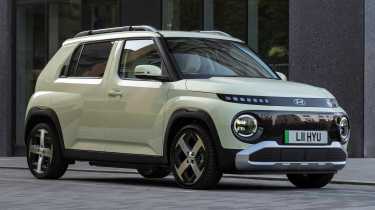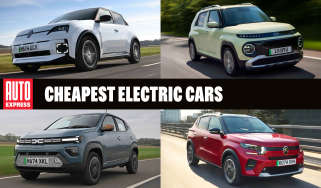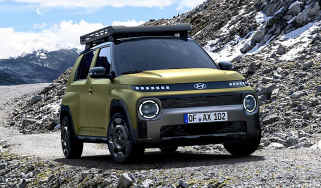Hyundai Inster review
The quirky, half-pint Hyundai Inster is a remarkably versatile, efficient and very lovable EV

Our opinion on the Hyundai Inster
The Hyundai Inster is a very charming and lovable small car that’s so spacious it feels almost like a Tardis on wheels – the cartoonish proportions and boxy shape help achieve that, and turn heads in the process. Meanwhile, the effortlessly efficient powertrain highlights Hyundai’s expertise in the field of electric cars once again. However, the plastic-heavy interior is a letdown, and based on our time behind the wheel, we feel the similarly priced Renault 5 is a more refined and sophisticated car.
| Key specs | |
| Fuel type | Electric |
| Body style | Five-door, four-seat city car |
| Powertrain | 42kWh battery, 1x electric motor, front-wheel drive 49kWh battery, 1x electric motor, front-wheel drive |
| Safety | 4-stars (Euro NCAP, 2025) |
| Warranty | Up to five years/unlimited miles |
About the Hyundai Inster
Ever heard of Casper? Not the friendly ghost, the Hyundai Casper. It’s a small, quirky city car that the brand only sells in its home market of South Korea. We actually got to drive the boxy little bundle of fun back in 2022, when we first heard rumblings about an electric version that might come to Europe to rival the reborn Renault 5 and Volkswagen’s entry-level EV, which we’re still waiting for.
Nearly three years on, and rather than the Casper, the new, still rather adorable Hyundai Inster has finally arrived in the UK. It joins the brand’s very successful line-up of electric cars, including two former Auto Express Car of the Year winners: the space-age Hyundai Ioniq 5 and the very capable Hyundai Kona Electric. There’s also the Hyundai Ioniq 6 saloon, and the huge Hyundai Ioniq 9 seven-seat SUV.
Used - available now

2026 Hyundai
Inster
1,449 milesAutomaticElectric
Cash £21,999
2026 Hyundai
Inster
556 milesAutomaticElectric
Cash £21,999
2026 Hyundai
Inster
1,679 milesAutomaticElectric
Cash £22,250
2026 Hyundai
Inster
841 milesAutomaticElectric
Cash £21,081If it wasn’t obvious, the Inster is now Hyundai’s entry-level EV, and is available from around £23,500. That’s a few hundred pounds more than the base R5, and a little higher than the Citroen e-C3, which won our 2024 Car of the Year award and now starts from just over £22k. Meanwhile, its much funkier sister car, the Fiat Grande Panda EV, is priced from over £21k.
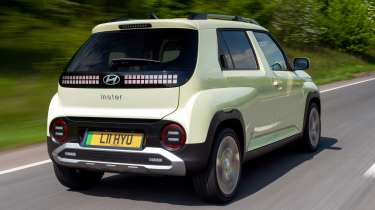
Ordering an Inster should be a straightforward process, because there are only three trim levels to choose from – 01, 02 and the 4x4-inspired Cross – and two battery sizes. The most basic model gets a 42kWh ‘Standard Range’ unit, while the rest feature a 49kWh ‘Long Range’ pack. However, it’s worth noting that the Inster is strictly a four-seater, like the Dacia Spring.
Standard equipment includes a heat pump that helps to preserve range in colder months, dual 10.25-inch displays, Apple CarPlay and Android Auto smartphone connectivity, 15-inch alloy wheels, climate control, keyless entry, a rear-view camera and adaptive cruise control, among other safety systems.
We strongly recommend springing for the 02 model, because it adds the bigger battery as standard plus extra kit including 17-inch rims, LED lights, roof rails, heated front seats, a heated steering wheel, a wireless charging pad, ambient interior lighting, fold-flat front seats and a sliding rear bench. Higher-spec models are also available with the option of black or beige-and-khaki-brown interior colour schemes.
For a rugged look, the Inster Cross adds chunkier front and rear bumpers, skid plates, embossed black side cladding, roof rails and a special set of wheels. The interior gets a unique colour scheme of grey cloth upholstery with lime-yellow accents that are echoed in the dashboard trim. An exclusive Amazonas Green Matte paint finish is also available for an extra £800.
Add the optional Tech Pack for a further £500 to any version of the Inster and it gets vehicle-to-load (V2L) charging capabilities, meaning you can use its main battery to power other electronic devices via a three-pin plug inside the car.
If you're interested in purchasing a Hyundai Inster, we can assist you. Configure your ideal Hyundai Inster now to get top offers from local dealers, check out the latest Hyundai Inster leasing deals or search for used Hyundai Inster models with our Find A Car service. You can even sell your existing car for a great price with Auto Express Sell My Car.
Performance & driving experience

Pros |
Cons |
|
|
The Inster benefits from not only Hyundai’s expertise when it comes to producing excellent electric cars, but also the simple fact that this is a very narrow car. Much narrower than its French foes, in fact. Its slim figure makes you feel like you can thread the Inster through any gap in traffic or sneaky side road you fancy. Although its decent motorway manners mean you needn’t feel confined to only city driving.
Performance, 0-60mph acceleration and top speed
The 42kWh battery is paired with a 96bhp electric motor that drives the front wheels, and is good for 0-62mph in a somewhat lethargic 11.7 seconds. By contrast, the 49kWh version comes with a slightly more potent 113bhp e-motor, which cuts the sprint time down to 10.6 seconds. The top speed is less than 100mph for both versions.
We tested the more powerful Inster, and acceleration feels peppy off the line, and up to around 30mph, which is perfect for a car born to tackle city streets. It can’t deliver the same punch as a Renault 5 because it has only half as much torque on tap; performance drops off significantly as you approach motorway speeds, and overtaking can take a while.
You can hear a faint whine from the electric motor when you’re accelerating too, but it’s not too bad, and you could easily drown it out by turning up the volume on the radio.
Town driving, visibility and parking
One advantage the Inster has over the Renault 5 (for now anyway) is the paddles behind the steering wheel that allow the driver to toggle between several strengths for the regen braking, including a proper one-pedal driving setting that’s perfect for constant stop-start traffic.
The turning circle is 10.6 metres, which is decent and the same as the Citroen e-C3. But we’d expect it to be tighter, especially considering that the Skoda Elroq – a much larger family SUV – has a 9.3-metre turning circle.
The upright windscreen and huge side windows, combined with the stubby front end with its flat bonnet, mean the view of the road ahead is excellent. Rear visibility is good too, but the thick C-pillars create a sizable blind spot when looking over your shoulder. Hyundai’s solution is exterior cameras that show what's in that blind spot when you indicate. We think it's a terrific feature, but for some bizarre reason, it's only found on the range-topping Inster Cross.
The low-speed ride in the Inster is nice and soft, but hitting a pothole can send jolts through the cabin. This is partly due to the dinky wheelbase, but also – we suspect – partly due to the relatively unsophisticated torsion beam suspension at the rear.
B-road driving and handling
Venture outside the city and pick up some speed, and the Inster reveals an underlying busyness to the ride that results in occupants being jostled about in their seats, and the car rolls in corners too. But you can carry some speed through them if you’re in the mood, so while the driving experience isn’t particularly thrilling, your passengers will be having a good laugh.
Motorway driving and long-distance comfort
As we mentioned, the Inster takes its time getting up to motorway speed. Once it’s cruising, it’s fairly loud inside because of the wind noise – no surprise given the size of the mirrors or the bluff front end of the car – but we also noticed some road noise and tyre roar too. Overall, the Renault 5 is noticeably more refined at high speeds.
Adaptive cruise control (which is standard fit) can help make long journeys more relaxing, while another handy feature is the ability to briefly activate maximum regen when exiting the motorway by holding down the left paddle on the steering wheel.
| Model | Power | 0-62mph | Top speed |
| Hyundai Inster 42kWh Standard Range | 96bhp | 11.7 seconds | 87mph |
| Hyundai Inster 49kWh Long Range | 113bhp | 10.6 seconds | 93mph |
Range, charging & running costs
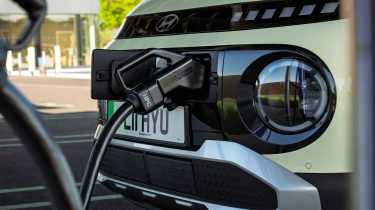
Pros |
Cons |
|
|
Although the Inster’s battery sizes are called ‘Standard Range’ and ‘Long Range’, there isn’t a vast difference between them. Hyundai says the 42kWh battery used by the most basic model (which we’ve yet to sample) will provide up to 203 miles of range, while the 49kWh unit is good for 229 miles on a single charge.
Key rivals like the Renault 5 and MINI Cooper Electric offer more range on paper, but the Hyundai makes up for that by being very efficient on the road. We weren’t trying to maximise range when we put the Inster through its paces, mostly on winding country roads and dual-carriageways with the air-con on max, yet the car still achieved 4.0 miles per kWh – better than we’ve been seeing from the Renault 5 on our test fleet.
Based on that average, the Inster could offer a real-world range of 196 miles from the 49kWh battery. Spend a little less time with the pedal to the metal, and we can guarantee that the efficiency figure will climb even higher.
Most people buying a car like this won’t be too worried about lightning-fast charging speeds, which is good because the maximum charging speed is 85kW, or 73kW in the smaller-battery model. That fails to match the 100kW or so rivals can hit, but it still only takes around half an hour to go from 10-80 per cent on a suitably speedy rapid charger for both battery sizes. Those charging at home using a conventional 7.4kW wallbox will find it'll take just over six hours to fully recharge the Standard Range Inster, while the Long Range version takes around 7.5 hours.
| Model | Battery size | Range | Insurance group |
| Hyundai Inster 42kWh Standard Range | 42kWh | 203 miles | 21 |
| Hyundai Inster 49kWh Long Range | 49kWh | 229 miles | 23-24 |
Insurance groups
The Hyundai Inster sits in insurance groups 21 to 24 (out of 50), depending on which version you go for, so it shouldn't cost a huge amount to get cover. The Renault 5 will be cheaper, though, because it manages to slide into groups 18 to 22, while the Citroen e-C3 should cost about the same, given that it falls into group 24.
Tax
From April 1 2025, electric cars attract the same annual rate of Vehicle Excise Duty (VED) or ‘road tax’ (£195) as any other car, although the Inster does avoid the £425 expensive vehicle supplement because it costs less than £40,000. The Benefit-in-Kind (BiK) company car tax rate for EVs is three per cent for the 2025/26 tax year.
Depreciation
Our latest expert data suggests that the Inster will hold onto around 40 per cent of its original list price after three years and 36,000 miles of ownership, which is slightly less than the Dacia Spring and Citroen e-C3 are projected to retain over the same period. However, the Renault 5 does much better because it's expected to hold onto about half of its value.
Check the price of a Hyundai Inster with our free car valuation tool...
Interior, design & technology

Pros |
Cons |
|
|
The boxy shape, bulbous wheelarches, comically large circular lights and extremely short overhangs were all features of the original Hyundai Casper. However, the square pixel lighting on the front and rear is taken from Hyundai’s other electric cars, such as the Ioniq 5 and Kona Electric. The charging port being located in the nose is something else we’ve seen in the brand’s EVs before.
We like the rather cartoonish design of the Inster, which reminds us of the Suzuki Ignis, and some of the wacky kei cars that are sold exclusively in Japan. This is a car that suits a more vibrant paint finish than the standard black, and thankfully, Hyundai offers various hues and finishes, with the stand-outs being Sienna Orange and Buttercream Yellow. Base models are fitted with 15-inch wheels, while the rest of the range gets a more impressive set of 17-inch diamond-cut rims.
Interior and dashboard design
Of course, plenty of other small electric cars have ‘quirky’ or ‘funky’ styling. The ace up the Inster’s sleeve is that its interior prioritises functionality, space and versatility. The most obvious sign of this is the sea of physical buttons littering the dashboard, including all the climate controls. There are more physical buttons on the steering wheel, and just behind it is the column-mounted gear selector.
Much like with the paint, the Inster’s standard black interior is very dull and doesn’t really suit this car’s personality, which is why we recommend opting for the beige and khaki brown colour scheme that's a no-cost option with 02 trim, with houndstooth seat upholstery like you can get in a Porsche 911 – that’s probably the only thing those two cars have in common, though.
Materials and build quality
There are next to no soft-touch materials throughout the cabin, which is disappointing as rivals like the Renault 5 manage to pepper in some fabrics or other materials in places. At least the overall build quality is solid, and we couldn’t hear any rattling or squeaking from the plastic trim in our test car.

Sat-nav, stereo and infotainment
Apple CarPlay and Android Auto are standard, as is the 10.25-inch touchscreen mounted on top of the dashboard, which we wish had been positioned lower to make it easier to reach.
The Inster doesn’t feature Hyundai’s very latest software, instead it uses an infotainment system that’s actually two generations old. Sure, it doesn’t look quite as slick or modern as the stuff in the brand's newer models, but the benefit of using older software is that Hyundai has ironed out all the kinks and bugs. It also gets the job done, and the graphics are clear; however, there are numerous menus to navigate through, and they can be quite laggy.
Boot space & practicality
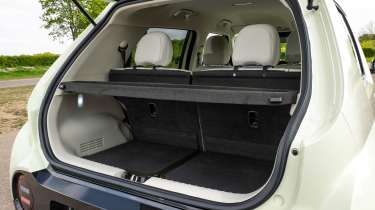
| Pros | Cons |
|
|
Hyundai has squeezed every possible millimetre of cabin space out of the Inster, managing to create a 3.8-metre-long city car with the Tardis-like quality of allowing six-foot adults to comfortably sit in the back of it. There are only four seats, however, and cabin storage is neither here nor there, with spaces on the dashboard and in the centre console to store odds and ends, but the door bins are only large enough for a wallet.
Dimensions and size
Measuring 3,825mm long, 1,610mm wide and 1,575mm tall, the Hyundai Inster is a little bit longer than the Dacia Spring, but shorter than its more direct rivals such as the Citroen e-C3, Renault 5 and Fiat Grande Panda.
| Dimensions | |
| Length | 3,825mm |
| Width | 1,610mm |
| Height | 1,575mm |
| Number of seats | 4 |
| Boot space | 238-351 litres |
Driving position, seats & space in the front
There’s plenty of adjustability in the steering wheel and captain’s chair to find a comfortable seating position. In between the front seats, which at a glance look like they’re one big bench, are a pair of cup-holders and a rather tiny armrest. Headroom is superb, and the view out is great, thanks to the tall body and large glasshouse.
The beige and khaki brown interior theme in our test car helps make the cabin feel even more airy and light, though there’s no escaping the fact that this is still a narrow car, and it feels it when there are two adults up front. The Renault 5 feels like a generally more spacious car for those in the front seats.

Seats & space in the back
There’s an obscene amount of headroom in the back, and the completely flat floor maximises all the available space. There are two sets of ISOFIX child-seat mounting points in the back for those with children to ferry around, and the back door opening is surprisingly wide to improve access. If you have adults to ferry around, opt for a higher-spec model, as the rear seats recline for added comfort.
Boot space
You have to upgrade to 02 or Cross trim in order to get the Inster with the 50:50-split sliding and reclining rear seats, which can be pushed forwards by up to 16cm. When they’re positioned for maximum rear legroom, the Inster offers just 238 litres of boot space, which is only slightly more than a MINI Cooper can muster, and a lot of that space is also found underneath the boot floor.
Sliding those seats all the way forwards will give you a significantly better 351 litres of boot space to play with, which is more than you get in the larger Citroen e-C3 or Renault 5. Another clever touch are the boards attached to the back of each rear seat, which help cover the void left when the rear seats are pushed forward, preventing loose items from falling down the gap. The Inster 01 doesn’t get any sliding rear seats, so it just has a 280-litre boot, which is smaller than most of this car’s rivals. Even the Dacia Spring can carry more junk in its trunk – 308 litres, to be exact.
When you need maximum cargo space, you can fold the front passenger seat down as well, and load items up to 2.2 metres long.
Reliability & safety
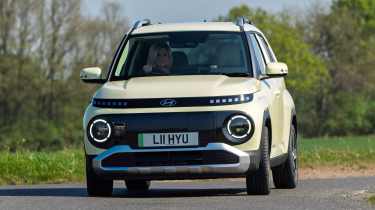
| Pros | Cons |
|
|
The Hyundai Inster received a four-star crash safety score from Euro NCAP in 2025, which isn't its highest rating, but it is on par with most of its closest rivals. Both the Renault 4 and Renault 5 also receive a four-star rating, but those seeking a car with the maximum five-star score will need to look towards the BYD Dolphin.
The Inster still gets lots of safety equipment, including seven airbags as standard (the Citroen e-C3 gets six) along with a smattering of driver-assistance systems, such as lane-keep assist, a driver-attention monitoring system, and forward collision avoidance assist with car, pedestrian, cyclist and junction turning detection.
Based on owners’ feedback from our most recent Driver Power satisfaction survey, Hyundai finished 20th (out of 31) in the best car manufacturer rankings, which is 10 places higher than BYD and 11 places up on last place MG. However, it is some way short of Renault, which managed to rank in sixth place.
| Key standard safety features | Euro NCAP safety ratings |
|
|
Buying and owning
Best buy: Hyundai Inster 49kWh 02
The entry-level Hyundai Inster comes well equipped with dual 10.25-inch displays, Apple CarPlay, Android Auto, keyless entry, a reversing camera and a smattering of safety kit. However, we recommend upgrading to the 02 trim, as it features a larger battery for extended range, a sliding and reclining rear bench for maximum versatility, and additional equipment, including heated front seats and a heated steering wheel.
Hyundai Inster and alternatives
The Inster is Hyundai’s champion in the small electric car class, which is more competitive than ever right now. The newest contenders include the reborn Renault 5 and incoming Renault 4, the MINI Cooper Electric, BYD Dolphin and our 2024 Car of the Year, the Citroen e-C3. There are also Citroen’s numerous siblings to consider, including the funky Fiat Grande Panda, the more practical Citroen e-C3 Aircross, and the Vauxhall Frontera. The Peugeot E-208 and Vauxhall Corsa Electric are also still on offer, but are a bit long in the tooth now.
Deals on the Hyundai Inster and alternatives
Hyundai Inster pictures
Frequently Asked Questions
The Hyundai Inster is incredibly spacious and versatile for such a small car, comes well equipped and proved to be very efficient during our testing. Its ability to put a smile on your face is a handy bonus.


